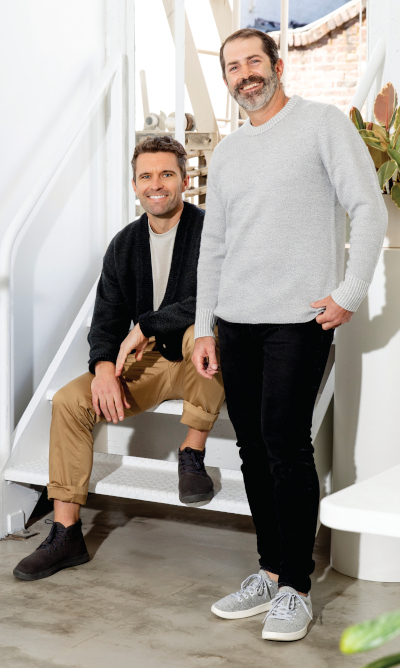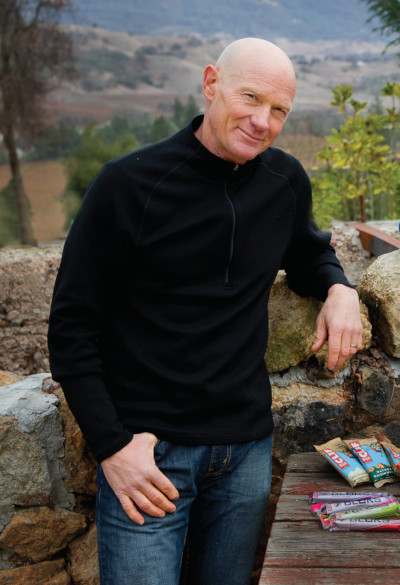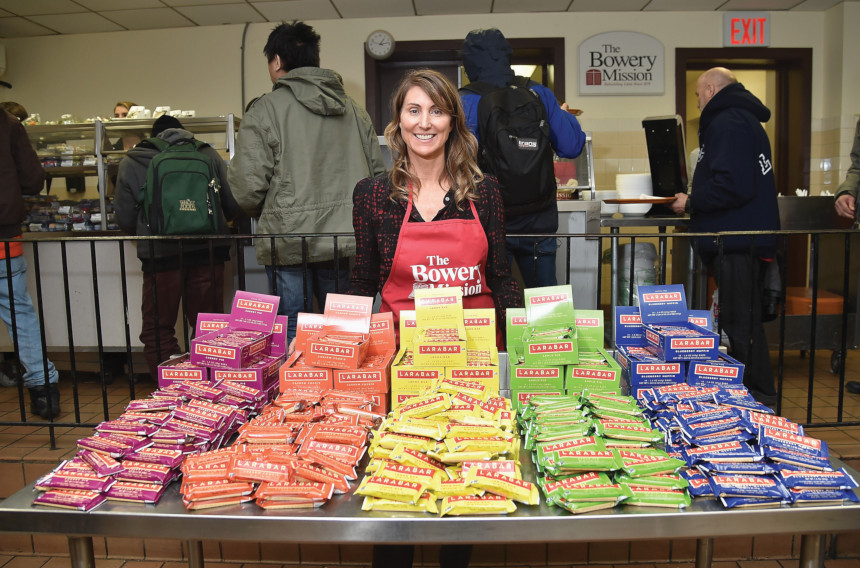Take a look around you right now. At the seat you’re sitting on. The shirt you’re wearing. The light bulbs illuminating the space you’re in. The phone in your pocket. Maybe the earbuds in your ears.
If these items have anything in common, it is that none of them looked like they do now when they were first conceived by the people who invented or designed them. And that’s because a lot happens between conception and first production for nearly every idea that gets turned into a business. Shape changes. Materials change. Offerings change. Names change. Process changes. Construction methods change. Look and feel and taste change.
As I type these words, I’m wearing a pair of Allbirds wool runner shoes. They’re super comfortable. When Tim Brown first conceived of the idea for a simple, clean, logo-less sneaker in 2009, the Merino wool fabric that has been the signature element of Allbirds since their debut in 2014 wasn’t even in the picture. The first shoes he produced, in fact, weren’t even called Allbirds; they were called TBs, and they were made from canvas and pieces of leather that he shipped from New Zealand to a factory in Indonesia, which produced two versions — high-top and low-top. Fit and comfort weren’t really part of the brand vision either. “It wasn’t about comfort at that time,” Tim said. “It was a design observation about a category that I thought was super complicated and overcrowded and over-logoed.”
Then Tim got a whiff, quite literally, of what went into making shoes, especially with leather, and his vision for his shoes began to change. “When I walked into a tannery for the first time,” Tim said, “it was an eye-opening experience. I started to understand where these materials were coming from. And what I realized was that the materials that shoes were made out of were not very nice. And I think that opened up the idea of exploring different materials.”

One of those materials was wool. “I remember reading a magazine one day about the wool industry in New Zealand,” Tim said. “And I was like, ‘Gosh, why is wool not used in shoes?’ And, ‘What if we could do that? That would be hugely interesting.’” Interesting because while the clean design of his shoe, and the story behind it, had resonated with customers enough to sell out virtually the entire 1,000-pair run of TBs at the pop-up shop in Wellington where Tim first sold them publicly (he sold his very first pairs to his teammates on the New Zealand national soccer team), his shoe really wasn’t differentiated enough for his taste. “It needed something more both for me and for the product,” he said.
So Tim applied to the New Zealand government for a grant from the Wool Research Board — which I swear is an actual thing — to develop a wool textile for the upper part of a shoe. To most people outside of New Zealand, particularly in the United States, this idea would have sounded kind of nuts. Wool is thick and heavy and often scratchy. It’s for sweaters and blankets and slippers, maybe, not shoes. But New Zealand’s Merino sheep produce an incredibly fine, soft wool with “miraculous properties,” as Tim described them. Merino wool wicks away moisture, regulates body temperature, and best of all, as anyone who has ever been caught in the rain wearing a wool sweater can attest, it doesn’t smell.
Of course, Tim was not the first person to figure out that Merino wool might be good for clothing. Merino sheep have been around since the 12th century; in Australia and New Zealand, they’ve been a staple since the late 1700s. But in 2009–2010, a similar Merino-based textile did not exist for shoes. “The problem,” Tim believed, was that outside of apparel, “wool was being marketed very, very poorly, despite the enormous innovation opportunity.” This was the case that Tim made to the Wool Research Board and how he was able to secure the research and development grant that ultimately produced the fabric that would go into the first Allbirds shoes in 2014 and into every other pair since.
There is a name for the creative process that Tim and his cofounder, Joey Zwillinger, went through, from canvas-and-leather TBs in 2009 to Allbirds Merino wool runners in 2014. It’s called iteration — the incremental evolution of a product or service. It is a phenomenon that is natural to innovation and foundational to the development of products as they come to market and vie for the attention of consumers.
Typically, there are two phases to the iterative process prior to launch. The first involves tinkering with your idea until it works and you, as its creator, are satisfied with what you have. The second entails exposing the working idea to the public and tweaking the product based on their feedback until it catches on — either with a buyer, a major investor, a retail partner, or a critical mass of customers.
“I was just kind of eating trail mix and thinking of food and raw foods and all of a sudden this light bulb goes off for me.”
—Lara Merriken of Lärabar
What makes the Allbirds story somewhat unique is that much of its evolution occurred in that first phase, before the shoes were ever exposed to consumers in any meaningful way. Many of the choices that Tim made — including, but not limited to, his experimentation with Merino wool — were driven by his own goals and preferences.
None of his teammates on the New Zealand national team, for example, had complained to him about the fit or the function or the look of those first canvas-and-leather TBs. But Tim didn’t like what went into making them, and he wasn’t all that excited about their sales potential. So he made the switch to wool and then went through 200-plus versions until he found something he loved. That’s really what Tim was getting at when he said the shoes needed something more “both for me and for the product.”
The goal, when you’re trying to break into an overcrowded market like Tim was, is to make something no one has ever seen before. Tim and Joey understood that — about the market and about themselves — nearly from the beginning, and they made the lion’s share of tweaks to their Allbirds shoe before nearly anyone else had a chance to see it and tell them to do things differently.
As Tim made clear when we spoke, it’s important to spend enough time in this first phase to really get comfortable with your product and your story and really get to know the business you’re trying to build. The exact amount of time you spend in the first phase of development isn’t as important as making sure you don’t get stuck there for too long. Every idea, no matter how great, has a shelf life. If you don’t get it off that shelf and out into the world in time, no amount of feedback you get during the second phase of the iterative process can overcome a lack of interest or mitigate first-mover advantage if someone beats you to the punch.
Moving to phase two can be tough for people who don’t handle criticism well, or who are dogged by that familiar yet unattainable form of perfectionism that has trapped the next great American novel on the desks or hard drives of countless aspiring writers since forever. Like asking friends and family for money, exposing your idea and all your hard work to feedback can be very uncomfortable, which can make the first phase of internal development feel like a safe space out of which you would rather not poke your head until you’re absolutely sure. Except “absolutely sure” doesn’t exist.
I would love to tell you a story about an entrepreneur who succeeded in spite of the paralysis of their perfectionism — but I don’t have one, because such people generally don’t create companies. The creators and innovators I spoke to, if they do struggle with criticism and perfectionism, also understand the importance of allowing their product to be judged by the marketplace, and the opportunity that users’ feedback presents to make the product better as a result. They know that they need an abundance of feedback to dial in their product. They actively seek it out, in fact. Because while they know what they want to do, and they know why and how they want to do it, they also know that they have no idea if anyone will actually like what they’re making. And that’s always essential to keep in mind.

Nowhere is this aspect of the iterative process more evident than in the energy bar business. Somehow, over the years, I’ve managed to interview the creators of three of them — Gary Erickson of Clif Bar, Peter Rahal of RXBar, and Lara Merriken of Lärabar. They are unique characters with similar entrepreneurial journeys, and I think what attracted me to their stories, as someone who loves to cook for other people myself, is just how fraught it can be to come up with a new recipe and then try to get it exactly right so people won’t just eat it, but they’ll love it, too. You think asking your friends and family for money is hard? Try asking them to taste your food and give you their honest opinion. Try getting them to tell you if it’s good, if they like it, what they like about it, if there’s anything they’d change, if there’s anything they’d like more or less of. I can tell you from experience that this can feel like an impossible task — one made even more difficult by the need to discern whose feedback to consider and whose to ignore, and then how to apply that feedback in such a way that it doesn’t send you back to the drawing board every time. It is a difficult but necessary process that took Gary Erickson six months, Peter Rahal seven months, and Lara Merriken three years to complete.
Each product started with an idea, of course. Gary, an avid cyclist living in Berkeley, California, got his in 1990 on a long, hilly ride through the Bay Area with a good friend. They were planning to do 125 miles, so each of them brought a banana and six PowerBars for fuel. At the time, PowerBars were the only readily available energy bars on the market, so every cyclist ate them — most, grudgingly. “When we were at the top of Mount Hamilton, I’d eaten five of those PowerBars, and I looked at the sixth one and I said, ‘No way. I can’t do one more. I would rather starve than eat another one of these,’” Gary recalled. Back then, the bars had a consistency somewhere between LaffyTaffy and Now and Laters, without any of the flavor benefits of candied sugar. “The bitter pill,” he called them. “I turned to my friend and said, ‘I can make a better energy bar than that.’”
A decade later, Lara, a social worker at the time, got the idea for her bar from the bottom of a trail mix bag at the top of a mountain outside Boulder, Colorado, on Memorial Day weekend in 2000. “I was just kind of eating trail mix and thinking of food and raw foods and all of a sudden this light bulb goes off for me,” she said. “‘Why hasn’t somebody made something made of fruit, nuts, and spices — just pure, simple, real foods — but it’s portable and convenient and it tastes indulgent like you shouldn’t be eating it?’”
In 2012, Peter Rahal came up with the idea for RXBar when, as a hard-core CrossFit enthusiast and an adherent of the paleo diet, he recognized that there was no energy or protein bar out there that met the strictures of that diet. “And the question was, why?” Peter said. “There’s this group of people that all do the same activity, that subscribe to the same nutrition values, and yet these gyms are selling water, they’re selling T-shirts, but no good-tasting bar that fulfilled the paleo criteria.” Not unlike Tim Brown’s sneakers, Peter’s idea was to fill that gap in the otherwise crowded energy bar space with something clean and simple.
Interestingly, conceiving of and getting down the rough outlines of the bars’ initial recipes — this is what the first phase of their iterative process entailed — didn’t take any of these creators all that long. Not 24 hours after Gary got home from his long ride, for instance, he called his mom, who’d helped him with recipes for the small bakery (Kali’s, named after his grandma) he currently owned, and enlisted her help with his energy bar idea. Her response was, “What’s an energy bar?” His answer was basically the foundation of the Clif Bar recipe. “It is kind of like that oatmeal–raisin–chocolate chip cookie you make,” he began, “but we can’t use butter, we can’t use sugar, we can’t use oil.” It was just going to be whole oats, real fruit, and a sweetener made from rice, all of which he would form into a rectangular shape, because “it was not going to be a cookie — it had to be like a bar.”
Lara didn’t even wait a full day to start tinkering. “I ran down the mountain,” she said, “I got out a notebook, and I started writing down ideas. And then when we got back to Denver, I would get ideas from pies and cookies and cakes. And I’d think, ‘Okay, how do I take cherry pie and make basically a raw, unprocessed food just in my Cuisinart and make it taste like cherry pie or apple pie or banana bread?’” The recipes came fairly quickly for her after that.
For Peter and his partner, Jared Smith, the initial phase was more of a process. “There was not this moment where it’s like, ‘Oh, we’re going to do it and commit,’” Peter said. “First, we’re like, ‘Let’s go to Whole Foods and tour the market. Let’s start playing around with ingredients.’ We just kind of did some preliminary market research and started learning.” Still, like Gary and Lara, they went into their tour with a clear vision for the product — a minimal-ingredient, paleo-friendly protein bar. “And the general philosophy around the product was that for whatever part of the formula, we wanted to make sure the ingredients were the best possible.”

It is precisely at this point in the iterative process that any one of these founders could have frozen in fear of negative feedback and let their idea get stuck in what Hollywood calls development hell. In retrospect, it would be hard to blame any of them if that had happened, because they each faced resistance to their idea from the people closest to them. Gary’s mom didn’t even know what an energy bar was. Lara’s parents, when she called them to share her idea, thought she was completely out of her mind. “They just thought, ‘We’ve sent her through private high school, USC, she’s graduated, she’s 32 years old … Oh my God, what’s going on here?’”
Lots of people told Peter his paleo protein bar was a bad idea, though not necessarily with their words. “I’d be very excited about it, and the look on their face was like, That’s a dumb idea,” Peter said, though he understood their skepticism … to a degree. “I mean, the market didn’t need another protein bar, that’s for sure. But we were just focused, and when we got some feedback, if it was negative, we were like, ‘We’re just going to do it anyway.’”
By the end of the summer of 2012, Peter was inundating the people at his CrossFit gym with samples. He’d moved into the second iterative phase of the development process. “We’d have logs of this RXBar dough, packed in Tupperware, and we would just get feedback,” Peter remembered of those early days — he at his CrossFit gym, Jared at the gym he belonged to. “You just ask a ton of questions: ‘Do you like this?’ ‘Do you not like this?’ ‘What would you like?’ ‘Would you pay for this?’ We collected tons of data.” All of that data went into refining the recipe for their first flavor, coconut chocolate, until mid-March 2013, when they made legitimate sales and collected real revenue for the first time. From there, they were off like a shot, selling online.
Lara’s path through the second phase of iteration was appreciably longer than Peter’s, since e-commerce solutions for food products were not as common or as popular in 2000 as they were in 2012. For Lara, it was going to be brick-and-mortar or bust. Still, despite the difference in length, the journey itself was the same. “I would make samples. I mean, batch after batch after batch that I would come up with using a Cuisinart that I’d had for years but never actually used,” Lara told me. “And I would do a focus group. I would create my own little survey, and I would ask people, ‘What do you eat energy bars for?’ ‘Why do you like them?’ ‘Why don’t you like them?’
Not 24 hours after Clif Bar creator Gary Erickson got the idea, he called his mom and enlisted her help with his energy bar idea. Her response was, “What’s an energy bar?”
“Then I would give them my concoctions and say, ‘Please tell me what you think.’” Which is exactly what they did. “They would give me feedback like, ‘I really like the cherry, but I don’t taste cherry in every bite,’ and I would go back and think, ‘I need to add more cherries. You should taste cherry in every bite.’” This was her development process for the five flavors — cherry pie, apple pie, banana bread, cashew cookie, and chocolate coconut chew — that she began selling in Denver-area Whole Foods stores in mid-2003.
For Gary’s part, a decade before, he nearly fell into the opposite of the perfectionist’s feedback trap, which can be equally perilous for a new product in development. “We had many failures,” Gary said. “And at times we tried to talk ourselves into them.” They’d tell themselves, “This is great,” having grown tired of all the experimentation and the feedback from Gary’s cycling friends, which was sometimes good, never great, and often really bad. “I would bring some out to my friends in plastic bags and say, ‘Okay, try this but keep it a secret,’ and they would be like, ‘This is terrible.’” That would send Gary back into the kitchen, despite an overwhelming desire at times to declare his new energy bar “good enough.” Finally, after six months of continued sampling, they landed on what they were looking for. “My mom and I just knew,” he said, describing the moment when they finalized the first Clif Bar recipe. “Then you take a risk, and you put a package around it, because you are never sure.”
All successful entrepreneurs are just as unsure as Gary Erickson was when he put a wrapper around the first Clif Bar, slapped a price tag on it, and put it up for sale. They made just as many tweaks in the early stages of development as Tim Brown did, based on gut instinct and personal preference, without knowing whether anyone would like them, let alone care. They ignored doubters like Peter Rahal did. And they stayed long enough in the first phase of iteration without staying too long (or forever), so that when they moved into the second phase for consumer feedback — like Lara Merriken did with her focus groups — they were putting their best foot forward. They were sending a version of their idea out into the world that they could stand behind. That is the real recipe for success in the iterative process, and one every creator needs to get right if they want to turn their idea not just into a product, but into a business that is poised for real, sustained growth.
Guy Raz is the host, co-creator, and editorial director of three NPR programs, including TED Radio Hour and How I Built This, as well as the creator and co-host of NPR’s first-ever podcast for kids, Wow in the World.
Excerpted from How I Built This: The Unexpected Paths to Success from the World’s Most Inspiring Entrepreneurs by Guy Raz. Copyright © 2020 by Guy Raz. Published and reprinted by permission of Houghton Mifflin Harcourt. All rights reserved.
This article is featured in the March/April 2021 issue of The Saturday Evening Post. Subscribe to the magazine for more art, inspiring stories, fiction, humor, and features from our archives.
Featured image: Khakimullin Aleksandr / Shutterstock
Become a Saturday Evening Post member and enjoy unlimited access. Subscribe now



